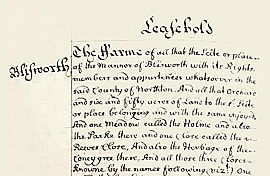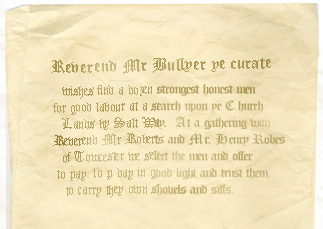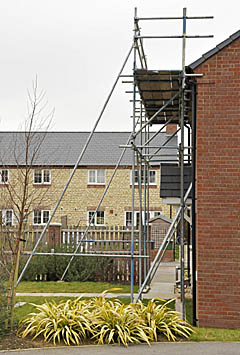|
A BLISWORTH FACT OR MYTH ? |
|
|
To follow up any of these subjects on the website please use keywords in the search box on the homepage. |
|
|
|
WINDMILLS When the canal was brought through Blisworth and Stoke Bruerne, it is said that the watermills were deprived of their water and so windmills were built to compensate the villages. This appears to be correct for Stoke Bruerne but not for Blisworth where both a water mill and a windmill were operated, well before the canal was built. In 1740 the Will of a miller includes a set of sail-cloths and in 1718 the watermill on the brook is described as an "overshott" type. |
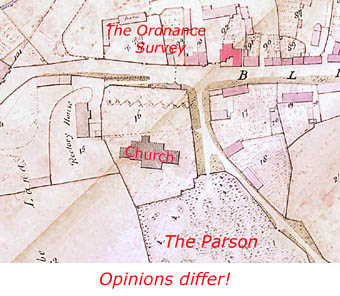
|
THE MANOR, WHERE ? It has been said that the Manor house was opposite the Church, complying with a general tradition in England in being to the north of the Church. Ordnance Survey maps, until recently, showed a mark there which was labelled "Manor - site of", being a record which would have dated from about 1850. Various articles and publications follow the OS interpretation but a teacher at our school just before WWII taught the alternative line that is given in the following. It is true that a big house with Tudor features once stood nearly opposite the Church (darker colour) and was pulled down in 1896. But it seems that it was merely given the name "Manor House" and was probably just a farmhouse. The actual Seat, once occupied by the Wake family before 1504, would have been an early version of the house behind the Church (ie. on the site of Blisworth House) according to a parson questioned by a historian clerk in the survey for John Bridges' History and Antiquities of the County. The clerk's notes amounts to the one and only record, made in 1718, for the Manor house location. That a telltale initialled date-stone had been covered up provides a plausible reason for the OS people not being able to follow up that record. We cannot go into the OS reasoning to prove this because all their records relating to Northamptonshire and many other counties were lost in the WWII blitz on Southampton. Who do you believe, the parson or the OS? |
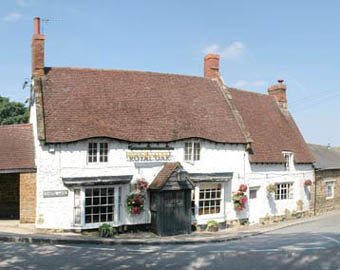 |
ROYAL OAK JAIL ? There has been mention recently* that the Royal Oak pub, perhaps as far back as 400 years, may have included a jail, upstairs and perhaps in the garret. Because records have been lost in a fire, there are no Grafton records further back than 1705. Oldest records are from Church and Chapel and from them there is some evidence for a medieval punishment cabin or stocks (a "Little Ease"), for wrong-doers, located 170 yards further down the lane but no known mention of a jail anywhere in the village. There probably was one though, somewhere. The village stocks were thought to be at the Courteenhall Road corner. * The originators of this myth have departed the village but also left us wondering where on earth is the 'indoor swimming pool' . . . . |

|
STATION HOUSE One of the two semi-detached stone houses known as Grafton Villas; namely, the one nearest to the railway archway has been fairly persistently referred to as the station office/waiting rooms that served the first railway station at the archway. There is even a printed article published somewhere, with a photograph of the villas captioned as "The Station", giving credit to this myth. The station building was on the other side of the main road with a wooden stairs up to the tracks. Interestingly, the house mentioned was tenanted by an early station master who was in charge at the second railway station (1843 - 1960) and this fact must have caused the confusion. The junction of Station Road with the main road is occasionally referred to as "Doctor's Corner". This is rather charming and refers to the times from 1849 to 1963 when a long succession of local doctors had their surgery at one of the two houses - this one is based on fact! A corrugated iron-clad hut was in use from c1930 to 1963 as a consulting room - it is about to be demolished. |
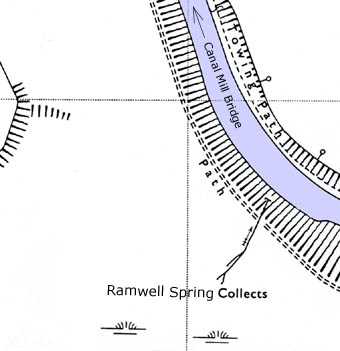
|
BLYDE'S SPA ? It may be claimed that the origin of Blisworth as a settlement relates to the Spa-like qualities of the spring water. The 'Domesday' recorded name of this village is Blidesworde which conveys a ward or enclosure (from worde, worth etc.) with properties promoting health and well-being (from the OE/old Danish blide). There is an early eighteenth century record referring to Ramwell Spring which is described as "a mineral water, & accounted good for sore and weak eyes" and which descends in the private grounds of the Manor House. From all this comes the idea of an invigorating spa. That the current name sounds like Bliss, which can be associated with well-being, and so on, seems almost too coincidental. The more usual interpretation of the village name is that the settlement belonged to someone called Blyde. Although this may be false, it is tempting to think of Blyde as a notable and aptly named health practitioner for Viking expats - then both interpretations could be correct. |
|
|
A bundle of ancient deeds relating to the Lordship of Blisworth was auctioned off at the "Butchers Livery Hall" in London on 3rd November, 1987. The vendor of the deeds was the present (12th) Duke of Grafton who lives at Euston Hall, Thetford. Although the earliest Lord of the Manor was a Norman endowed at the time of Domesday, the 1st Duke of Grafton was created "Lord of the Manor" of Blisworth in 1673. These deeds entitle the buyers, who were apparently Tony and Denise Georgiou once of Stoke Road, to use the title of "Lord of the Manor" - so had we better keep a watch to avoid loosing any traditional villagers' rights? Let's not worry - the deeds surely have only curiosity value. They probably schedule rights to certain common land and an annually reviewed right to cultivate strips in certain fields. There may be rulings against such things as taking liberties with your stock; whether they be pigs or geese etc. and if the 'squire' wishes to hunt in Blisworth without obligation to repairs then let's welcome some long awaited entertainment. It would be appreciated if the Georgious could allow us to photograph the deeds - again, just for curiosity value. |
|
|
“Reverend Mr Bullyer ye curate wishes find a dozen strongest honest men for good labour at a search upon ye Church Lands by Salt Way. At a gathering with Reverend Mr Roberts and Mr. Henry Robes of Towcester we select the men and offer to pay 1d p day in good light and trust them to carry they own shovels and siffs.” This curious piece, laid out as a small advert but lacking any date or venue, was found almost glued with rust to the bottom of the parish iron box. It appears to be the preparation for “a dig” – either with archaeological purpose or to find something that was lost. Presumably the intent of Mr Robes would have given some clue. The date must have been in the early 18th century, c1718, because that is when the two reverends mentioned were at Blisworth. There is certainly no evidence in our archives of a sudden increase in the wealth of the Church so perhaps nothing much was found. |
|
|
INTERPRETATION BOARD On the village interpretation board near the Westley corn
mill are given the following points: Furthermore, the "You are here" arrow is rather mischievous since the board could not be placed where it was originally envisaged! But we can move it back by computer for the picture here! |

|
GAYTON ARM ? The name 'Arm' refers to the arm of the Grand Union Canal which joins there and provides a waterways link with Northampton. Hence the place was originally called Northampton Arm but for some inexplicable reason the name "Gayton Arm" was introduced around about the time the first marina called itself "Gayton Marina". This naming was probably done to avoid the inevitable confusion with any boatyard or moorings at Blisworth mill. Even some of the villagers of Gayton claim the place is part of Gayton but, in fact, the whole hamlet and the first part of the waterways arm are all, very definitely, in the parish of Blisworth. The highways department wisely support the name "Blisworth Arm" for the hamlet. It has been pointed out to me (D. Blagrove) that other names in use are "Gayton Junction" as catalogued c1928 in Bradshaw's "Canals and Navigable Rivers" and "Arm End" by boat-people and the name assigned to the first bridge encountered on the Arm. |
|
|
BLISWORTH GHOSTS ! There are three in number, namely; the tunnel
ghost which supposedly recalls the true story of a tragedy of an
entanglement between two boats in the tunnel in 1861 with cries of the
drowning and choking. There's a variation involving flickering
candle-light and baby crying at a dimly seen forked junction within the
tunnel. There's also the fork with some steady lights and a
feeling of confusion as to which way to steer the boat (no crying
baby). People say the fork is where an earlier attempt at a tunnel
line crosses the existing tunnel. |
|
|
IN NEED OF SOME WISER COUNSEL ? Councils, whether of the parish or the county persuasion, tend to be ridiculed in reprisal for their 'red tape' or the heartless way they impose taxes. Some of them really work hard to attract derision. In this case the SNC has taken on the duty of paying for the scaffolding placed against this Ladyfield house so that work may be carried out in accordance with H&S. The work was finished many weeks earlier but the council have forgotten the name of the scaffolding contractors, who had left no trader's sign. What else could the SNC do but agree to continue paying them (from Dec 08 - March 9th 09). It seems far fetched that the council could not find out who were the contractors but perhaps an intermediary has created communication problems. It is all true but sounds like a myth in the making especially as this story probably will become embellished over the years! |

